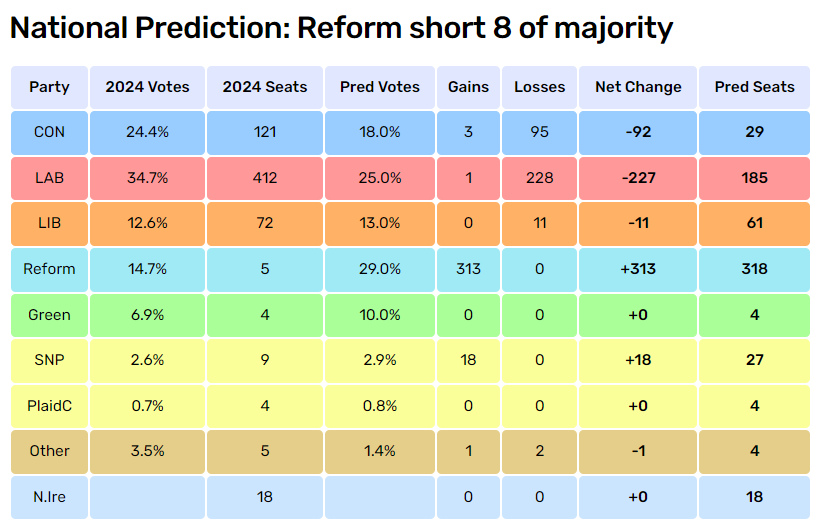Pollster: Opinium
Sample size: 2,050
Fieldwork dates: 14th-16th May 2025
Source
Key points
If Reform formed a government with Tory support, it could accelerate calls for electoral reform.
The Tories’ strategy is nearly impossible to adjust, losing voters on every flank.
Fewer than 25% of over 65s support the Conservatives.
Opinium is a useful pollster to watch because they don’t poll as regularly, meaning they tend to monitor long-term trends rather short-term blips; which is why this poll really ought to be paid attention to, and this post looks at the previous post closely.
Two weeks passed between the local elections that saw Reform break through in the Midlands, the North East, and Lincolnshire, and the fieldwork for this poll. As a result, this continual increase in Reform’s numbers suggests a continual and perhaps permanent dominance. Just as equally, the Greens’ rise is equally continual, while the decline of the Conservatives might be permanent, and in freefall.
What would this parliament look like?
The Electoral Calculus predictor suggests Reform would be just eight seats short of forming a majority government:
Despite only a 2% increase in the poll numbers, that is 35 seats more than the previous poll suggests; we’re entering a period when the First Past the Post system is going to be tested to its limits. Designed to provide decisive, stable governments, it is a creaking ship in an era of political radicalisation and divisive populism. If the Conservatives really do evaporate to 29 seats, Reform may be forced into a Confidence and Supply Agreement (CSA) with the Tories in the same way Theresa May was in 2017. Such CSAs are highly unstable, resulting in perhaps more political instability and greater calls for electoral reform, even and especially by the party that benefits from FPTP in this instance.
There are some interesting trends compared to last month, though; the Conservatives have risen marginally in the North and Wales, but has fallen noticeably in Scotland, the Midlands, and the South, all by 3%. What’s remarkable is this would be due to different competitors in different regions; the SNP in Scotland, Reform in the Midlands, and the Lib Dems in the South. That makes it very difficult for the Tories to pivot and strategise to win voters back, because each voter base has different and often competing interests.
In comparison, Labour have picked up quite notably in Scotland (by 4%), but fallen in the South (3%), London (4%) and Wales (2%). These are in areas where shifts produce significant outcomes, as they are close races and open to disruption; likewise, the SNP has fallen by 4%, which has major impacts for results in Scotland.
In the age groups, the Conservatives’ vote share in their most important bloc - the over 65s - has fallen by an enormous, and completely unsustainable, 7%, while Reform has become the dominant party amongst this age group, taking more than the Tories, Labour and Greens combined. If the Conservatives’ support in this group is less than 25%, they really are in extinction territory.
And it’s in the balance between men and women that the polling is most confirmatory. I’ll keep pointing it out, because it needs to be; Reform’s lead amongst women is, as of right now, cemented, by a solid 4% over Labour and a whopping 9% over the Conservatives. Reform is still performing worse amongst women than amongst men, but at this stage, that isn’t really a concern, and the historic reality is that women tend to be less politically motivated than men, with lower turnout.
Thank you for reading this short Poll Watch post, in which I look at and discuss the most recent public opinion survey. Please consider subscribing to and sharing this blog and, if you’re feeling particularly generous, subscribing to my paid content -(detailed research and policy proposals).


